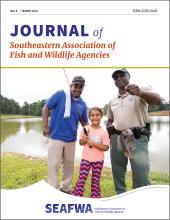Box-nesting Wood Ducks and Black-bellied Whistling Ducks in Coastal South Carolina
Installation and maintenance of artificial nesting structures are established practices for increasing production of secondary cavity nesting waterfowl, especially wood ducks (Aix sponsa). In South Carolina, tens of thousands of nest boxes have been erected on public and private lands. Ad- ditionally, since the early 2000s, black-bellied whistling ducks (Dendrocygna autumnalis) have expanded their range into South Carolina and now are nesting sympatric with wood ducks in boxes. We conducted a survey of 364 and 354 nest boxes in 2016 and 2017,...
